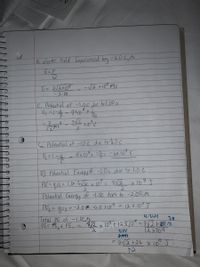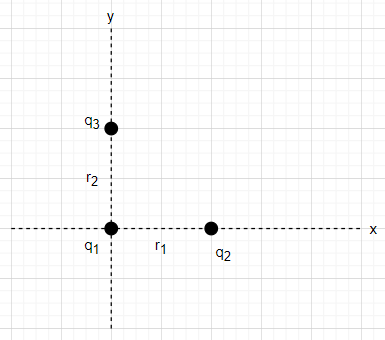Question
thumb_up100%
I am struggling with B and D.

Transcribed Image Text:A 1.0 C charge, a-2.0 C charge, and a -1.0 C charge are oriented as shown below. The dashed lines are not wires. They are just intended to show the geometry.
1.0C
I 3.0 m
3.0 m - --
-2.0 C
1.0 C
a) What is the magnitude of the electric force on the -2.0 C charge?
b) What is the magnitude of the electric field experienced by the -2.0 C charge?
c) What is the electric potential (voltage) due to the 1.0 C charge and the -2.0 C charge at the location of the -1.0 C charge?
d) What is the electric potential energy of the -1.0 C charge when in this configuration?
e) Reproduce the sketch of a distribution of charges (shown below) on your paper. Draw in the electric field lines and label regions of high and low potential (voltage). Briefly
describe the path of an electron if you placed it in the center of the charge distribution. Use either electric field or electric potential as you answer the question. Iwill not read
more than two simple sentences or phrases, so keep your answer to the point.

Transcribed Image Text:15 electic field Expeienced by -2.0cm
E=F
E= 2/2x109
-2.00
ース×10°円ム
C. Polentiel at -Lbc due tol.00 G
こ3
312
C Potential ut -10 c due to do C
D) Potential Energyf -1.0c due to l.0C
PE-qU,= 1.0= 3N e x 10" = 312 xl0? Ţ
Polential Energy of 1.00 does to -2.0cM
12 X 10" J
ニ
Total PE of -1.0CM
PE= At PE,
4.2W4
28
312x10 t tâ X I0ot =37/2 +112
1ax109
11.24
-a +26 x 10 J
9.
Expert Solution
arrow_forward
Step 1
The electric field due to multiple charges is given by the vector sum of the electric fields due to all the charges. The given configuration of charges in the question is shown in the diagram below

Trending nowThis is a popular solution!
Step by stepSolved in 7 steps with 1 images

Knowledge Booster
Similar questions
arrow_back_ios
arrow_forward_ios